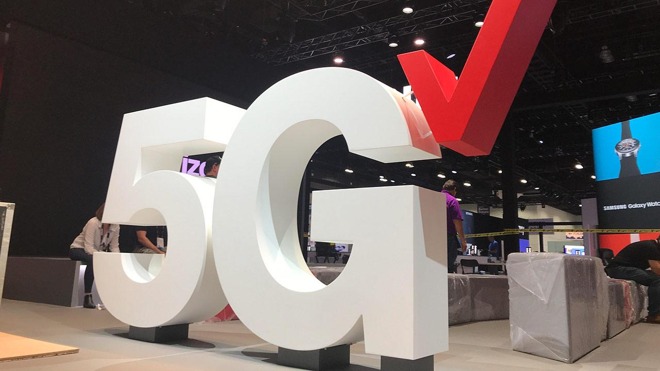Verizon enables 5G uploads, 30% speed increase over 4G
Verizon on Wednesday said that it has enabled 5G uploads in all of its current 5G markets in the U.S., though coverage in those areas might be limited.

A Verizon 5G sign at Mobile World Congress Americas in 2018. Credit: Verizon
While Verizon was among the first to roll out a functional 5G network in the U.S., the speedy protocol was restricted to data downloads with uploads handled by 4G LTE. That changed on Wednesday when the carrier enabled 5G uploads, saying customers will see an average 30% speed increase over LTE.
It's worth noting that a Verizon footnote points out that "5G upload coverage area differs from 5G download coverage area." The carrier didn't elaborate on what, exactly, that means.
Since it's still early in 5G's rollout, there are still some major caveats for most consumers. Verizon's 5G Ultra Wideband is only available in select parts of certain cities and requires a 5G-compatible smartphone. Apple is expected to release its first 5G-enabled iPhone sometime in 2020.
Verizon also announced that San Diego will become the 35th market to receive 5G Ultra Wideband service on May 28.
"Our customers' need for 5G is accelerating. We're building our 5G Ultra Wideband network to develop and enable the 5G innovations that will support the changing behavior of consumers, businesses and entire industries," said Verizon CTO Kyle Malady.
Verizon's low-band 5G networks, which will make up the second part of its 5G deployment, are due to launch later in 2020.

A Verizon 5G sign at Mobile World Congress Americas in 2018. Credit: Verizon
While Verizon was among the first to roll out a functional 5G network in the U.S., the speedy protocol was restricted to data downloads with uploads handled by 4G LTE. That changed on Wednesday when the carrier enabled 5G uploads, saying customers will see an average 30% speed increase over LTE.
It's worth noting that a Verizon footnote points out that "5G upload coverage area differs from 5G download coverage area." The carrier didn't elaborate on what, exactly, that means.
Since it's still early in 5G's rollout, there are still some major caveats for most consumers. Verizon's 5G Ultra Wideband is only available in select parts of certain cities and requires a 5G-compatible smartphone. Apple is expected to release its first 5G-enabled iPhone sometime in 2020.
Verizon also announced that San Diego will become the 35th market to receive 5G Ultra Wideband service on May 28.
"Our customers' need for 5G is accelerating. We're building our 5G Ultra Wideband network to develop and enable the 5G innovations that will support the changing behavior of consumers, businesses and entire industries," said Verizon CTO Kyle Malady.
Verizon's low-band 5G networks, which will make up the second part of its 5G deployment, are due to launch later in 2020.

Comments
There are auto-upload functions on phones of course, like when you take a photo or video and it will get auto-uploaded to the cloud to your iPhoto library, but I always make sure that all of that stuff is disabled if I'm taking pictures or shooting video with my phone outside, because I don't use unlimited data.
My current plan is 3GB a month I think, and that's plenty for me. I don't even end up using 1 GB of it probably. I do have unlimited data at home of course.
I've actually had unlimited data for my phone for free for a few months now, because of the virus crap, and I haven't bothered to use any of it. What am I supposed to do, walk around outside streaming 4K netflix on a phone for hours every day? No thanks.
These carriers are dancing as fast as they can around the fact that "low-band" (sub-6GHz) 5G -- the kind 90+ percent of us are ever going to see -- is nothing more than a modest increase from LTE. You'll have to wait much longer (and be near the small and limited test sites) for mmWave to roll out and for some unknown breakthroughs to happen to overcome its many obstacles before you'll see any difference you would really and immediately notice as dramatically different than LTE.
I'm in no way against this technology, but the way it has been bamboozled through the corrupt FCC and hoodwinked public is absolutely shameful.
TikTok is a video-sharing social networking service owned by ByteDance, a Chinese company founded in 2012 by Zhang Yiming. It is used to create short dance, lip-sync, comedy and talent videos.
I guess that explains why I've never been on TikTok.
I’m not sure why you’re arguing about this though. The carriers have laid out their 5G strategies already. I’m not speculating here. They’ve said mmWave is for cities, mid band is for suburbs and low band is for rural areas.
"When you want to do something big always ask the experts first. They'll tell you what can't be done and why. That way you know what pitfalls to avoid."